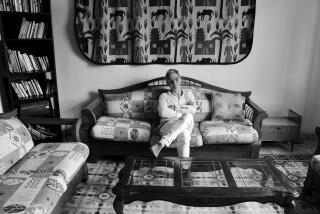AS I WRITE THIS LETTER : An Andean Indianâs 30-Year Expose of Spanish Colonialism and Abuse Sketches a Complex Portrait in Fullerton
In 1585, an Andean Indian named Felipe Guaman Poma de Ayala decided that someone had to be told about the abuse of the native population in Peru by the colonial Spaniards.
So he began penning a letter to King Philip III of Spain--an extraordinary manuscript that took 30 years to complete. In the 1,188-page work, Guaman Poma included 398 line drawings showing everything from historical scenes of the Spanish conquest of the Incas to depictions of abuse of Indians by colonial administrators.
At first viewing, the drawings seem straightforward, untutored representations of events and places, heavily influenced by European book illustration. But beneath the surface, scholars say, is a hidden language of symbology and spatial relationships that connects the Andean author to his native culture.
Wall-mounted reproductions of the works, together with artifacts of colonial-era Peru, form the basis of âGuaman Poma de Ayala: The Colonial Art of an Andean Authorâ on display at the Fullerton Museum Center through Nov. 29.
The drawings âseem very simple, very naive at first. One of the points of the exhibition is that they are not naive at all,â explained Mercedes Lopez-Baralt, curator of the exhibition. The historian, based at the University of Puerto Rico, has made the images a focus of her academic career.
âAfter years of studying them,â she said, âI realized that sometimes these drawings can produce contradictory images and contradictory messages.â
In one banquet scene, for instance, âyou can see on a tray what seems to be a roasted chicken,â Lopez-Baralt said. âIf you take a look, itâs actually a female body.â The tray is being presented to a Spaniard by a native server; the symbolic meaning of the drawing relates to the sexual servitude of Andean women to their colonial masters, Lopez-Baralt said.
In other cases, the spatial relationship of elements within the drawings has meaning. For example, in one drawing of a conquistador defeating an Inca warrior, the Inca is placed on the right (from the viewpoint of figures within the picture), a position that emphasizes his moral superiority, even in defeat.
âThe symbolic positions of figures within the visual space are charged with an ethical judgment made by the author,â Lopez-Baralt said. So, a drawing picturing a defeat of the native warrior âcould be read also as a message of hope.â Such symbolic positioning is used throughout Guaman Pomaâs work, Lopez-Baralt said.
Guaman Pomaâs manuscript (titled âNueva coronica i buen gobiernoâ-- âNew Chronicle and Good Governmentâ) even went so far as to offer the king of Spain his advice on a better government. The writer finished his mammoth task in 1615, but the next three centuries in the manuscriptâs history are a blank. The work came to the attention of historians when it turned up in 1908 in the Royal Library of Copenhagen.
The discovery set in motion a continuing flow of scholarly interest, but the manuscript and its extraordinary author have remained unknown to the public. The New York-based Americas Society is attempting to change that in this quincentenary anniversary of Columbusâ arrival with this exhibit, first displayed in New York.
Rather than simply a work of historical interest, Guaman Pomaâs manuscript embodies the questions of cultural identity that continue to face Latin America today, questions that have been underscored by the debates generated by the Columbus quincentennial.
Modern audiences âshouldnât be looking at it as some archaic or distant subject. Itâs very much alive,â Lopez-Baralt said. âItâs very important, I think, that this text shows the rich complexity of Latin America. We are culturally and linguistically very mixed.â
What: âGuaman Poma de Ayala: The Colonial Art of an Andean Author.â
When: Noon to 4 p.m. Tuesdays, Wednesdays, Saturdays and Sundays; noon to 9 p.m. Thursdays and Fridays, through Nov 29.
Where: Fullerton Museum Center, 301 N. Pomona Ave., Fullerton.
Whereabouts: Take the Orange (57) Freeway to the Chapman Avenue exit. Drive west along Chapman to Pomona Avenue (one block past Lemon Street) and turn left.
Wherewithal: $2 for adults, $1 for students and seniors, free to museum members and children under 12. Free to all visitors on Thursdays from 6 to 9 p.m.
Where to call: (714) 738-6545.
More to Read
The biggest entertainment stories
Get our big stories about Hollywood, film, television, music, arts, culture and more right in your inbox as soon as they publish.
You may occasionally receive promotional content from the Los Angeles Times.










